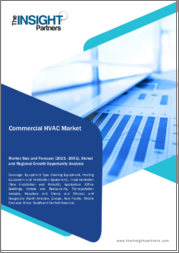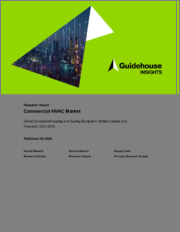
|
시장보고서
상품코드
1596898
상업용 HVAC 시장 규모, 점유율, 성장 분석 : 부문별 및 지역별 산업 예측(2024-2031년)Commercial HVAC Market Size, Share, Growth Analysis, By Type (Heating, Ventilation), By Component (Compressors, Condensers), By System (Variable Refrigerant Flow (VRF), Air Handling Units (AHU)), By Region - Industry Forecast 2024-2031 |
||||||
상업용 HVAC(Commercial HVAC) 시장 규모는 2022년에 502억 7,000만 달러로 평가되었고, 2023년 517억 달러에서 2031년에는 665억 2,000만 달러로 성장 할 것으로 예상되며, 예측 기간(2024-2032년) CAGR은 2.84%로 추이하며 성장할 전망입니다.
세계의 상업용 HVAC(난방, 환기, 공조) 시장은 도시화 증가, 상업 부문 확대, 에너지 효율과 지속가능성에 대한 인식 증가 등의 요인에 힘입어 크게 성장할 것으로 전망됩니다. 실내 공기질 개선과 환경 영향 최소화를 목표로 하는 엄격한 규제로 인해 상업용 건물, 사무실, 소매 공간에서 HVAC 시스템에 대한 수요가 증가하고 있습니다. 기업이 인프라를 개선하고자 할 때, 쾌적한 실내 환경을 보장하고 입주자의 생산성과 웰빙에 직접적인 영향을 미치는 고급 HVAC 솔루션에 대한 요구가 증가하고 있습니다. 자동화 및 IoT 기능을 통합한 스마트 HVAC 기술은 에너지 사용과 운영 효율성을 최적화하는 원격 모니터링 및 예측 유지보수와 같은 이점을 제공하며 주목을 받고 있습니다. 지역적으로는 북미와 아시아 태평양 지역이 주요 시장으로 부상하고 있으며, 인프라 개발이 활발히 진행되고 있습니다. 또한 신흥 경제국의 급속한 도시화와 산업 성장으로 인해 견고한 산업용 HVAC 시스템에 대한 수요가 증폭되고 있습니다. 기업이 시설을 발전시키고 업그레이드함에 따라 보다 효율적인 냉난방 솔루션의 필요성이 중요해지고 있습니다. 혁신과 지속 가능성 사이의 상호작용은 상업용 HVAC 환경에서 변화의 국면을 맞이하고 있으며, 경쟁이 치열하고 환경을 생각하는 시장에서 번창하고자 하는 현대식 건물에 필수적인 요소로 자리매김하고 있습니다. 이러한 추세는 상업용 HVAC 부문의 유망한 궤적을 나타내며, 실내 기후와 운영 효율성을 개선하는 데 있어 그 중요성을 강조합니다.
목차
소개
- 조사 목적
- 조사 범위
- 정의
조사 방법
- 정보 조달
- 2차 및 1차 데이터 방법
- 시장 규모 예측
- 시장 전제 조건 및 제한 사항
주요 요약
- 세계 시장 전망
- 공급 및 수요 동향 분석
- 부문별 기회 분석
시장 역학 및 전망
- 시장 개요
- 시장 규모
- 시장 역학
- 성장 촉진요인 및 기회
- 억제요인 및 과제
- Porter's Five Forces 분석 및 영향
- 경쟁 기업간 경쟁 관계
- 대체품의 위협
- 구매자의 협상력
- 신규 진입업자의 위협
- 공급기업의 협상력
주요 시장 인사이트
- 중요 성공 요인
- 경쟁도
- 주요 투자 기회
- 시장 생태계
- 기술 진보
- 규제 상황
- 밸류체인 분석
- 사례 연구 분석
- PESTEL 분석
- 공급망 분석
상업용 HVAC 시장 규모 : 유형별
- 시장 개요
- 난방
- 환기
- 에어컨
상업용 HVAC 시장 규모 : 구성 요소별
- 시장 개요
- 컴프레서
- 커패시터
- 증발기
- 컨트롤
상업용 HVAC 시장 규모 : 시스템별
- 시장 개요
- 가변 냉매 유량(VRF)
- 에어컨 유닛(AHU)
- HVAC 컨트롤
상업용 HVAC 시장 규모 : 지역별
- 북미
- 미국
- 캐나다
- 유럽
- 영국
- 독일
- 스페인
- 프랑스
- 이탈리아
- 기타 유럽
- 아시아 태평양
- 중국
- 인도
- 일본
- 한국
- 기타 아시아 태평양
- 남미
- 브라질
- 기타 남미
- 중동 및 아프리카
- GCC 국가
- 남아프리카공화국
- 기타 중동 및 아프리카
경쟁 정보
- 상위 5개사 비교
- 주요 기업 시장 포지셔닝(2023년)
- 주요 시장 기업이 채택한 전략
- 시장의 최근 동향
- 기업 시장 점유율 분석(2023년)
- 주요 기업 프로파일
- 기업 개요
- 제품 포트폴리오 분석
- 부문별 점유율 분석
- 수익 전년대비 비교(2021-2023년)
주요 기업 프로파일
- Samsung Electronics
- Carrier
- Trane
- Lennox International Inc.
- Daikin Industries, Ltd.
- Ruud
- American Standard
- Bryant
- Johnson Controls International plc
- Emerson Electric Co.
- Mitsubishi Heavy Industries, Ltd.
- Rheem Manufacturing Company
- Goodman Global Services, Inc.
- York International Corporation
- Amana Corporation
- Hitachi Appliances, Inc.
- LG Electronics Inc.
- Electrolux AB
- Trane Technologies plc
- Emerson Climate Technologies Inc.
결론 및 권장사항
LYJGlobal Commercial HVAC Market size was valued at USD 50.27 billion in 2022 and is poised to grow from USD 51.7 billion in 2023 to USD 66.52 billion by 2031, growing at a CAGR of 2.84% in the forecast period (2024-2032).
The global commercial HVAC (Heating, Ventilation, and Air Conditioning) market is poised for significant growth, propelled by a confluence of factors such as rising urbanization, the expanding commercial sector, and growing awareness around energy efficiency and sustainability. The demand for HVAC systems in commercial buildings, offices, and retail spaces is on the rise, partly due to stringent regulations aimed at improving indoor air quality and minimizing environmental impacts. As businesses aim to enhance their infrastructure, there is an increasing need for advanced HVAC solutions that ensure comfortable indoor environments, directly influencing occupant productivity and well-being. Smart HVAC technologies that integrate automation and IoT capabilities are gaining traction, offering benefits like remote monitoring and predictive maintenance which optimize energy use and operational efficiency. Regionally, North America and Asia-Pacific stand out as major markets, driven by significant infrastructure developments. Furthermore, the swift urbanization and industrial growth in emerging economies are amplifying the demand for robust industrial HVAC systems. As companies evolve and upgrade their facilities, the need for more efficient heating and cooling solutions becomes critical. The interplay between innovation and sustainability is marking a transformative phase in the commercial HVAC landscape, positioning it as a vital component for modern buildings looking to thrive in a competitive, environmentally-conscious marketplace. These trends indicate a promising trajectory for the commercial HVAC sector, underscoring its importance in facilitating improved indoor climates and operational efficiencies.
Top-down and bottom-up approaches were used to estimate and validate the size of the Global Commercial Hvac market and to estimate the size of various other dependent submarkets. The research methodology used to estimate the market size includes the following details: The key players in the market were identified through secondary research, and their market shares in the respective regions were determined through primary and secondary research. This entire procedure includes the study of the annual and financial reports of the top market players and extensive interviews for key insights from industry leaders such as CEOs, VPs, directors, and marketing executives. All percentage shares split, and breakdowns were determined using secondary sources and verified through Primary sources. All possible parameters that affect the markets covered in this research study have been accounted for, viewed in extensive detail, verified through primary research, and analyzed to get the final quantitative and qualitative data.
Global Commercial Hvac Market Segmental Analysis
North America is expected to dominate the commercial HVAC market. The region's dominance can be attributed to factors such as a mature construction industry, stringent energy efficiency regulations, and a high demand for advanced HVAC technologies in commercial spaces. The United States is a significant contributor to market growth due to extensive infrastructure development and a focus on sustainable building practices.
Driver of the Global Commercial Hvac Market
The Global Commercial HVAC market is significantly driven by the surging demand for energy-efficient and sustainable HVAC solutions, largely catalyzed by heightened environmental consciousness and stricter regulatory frameworks. As the commercial sector, encompassing offices, retail establishments, and healthcare facilities, continues to expand, the requirement for sophisticated heating, ventilation, and air conditioning systems becomes increasingly pronounced. Moreover, advancements in technology, particularly the emergence of smart HVAC systems featuring IoT integration, are revolutionizing energy management practices and enhancing occupant comfort. This confluence of factors is propelling the adoption of innovative HVAC solutions, solidifying their essential role in modern commercial environments.
Restraints in the Global Commercial Hvac Market
One of the primary constraints facing the Global Commercial HVAC market is the significant initial investment required for advanced HVAC technologies, which can be particularly burdensome for small and medium-sized enterprises. Economic uncertainties and variable construction activity further complicate the situation, potentially stifling market expansion. Moreover, retrofitting old structures with modern HVAC systems can introduce logistical complexities and elevate expenses. While stringent regulatory requirements aimed at enhancing energy efficiency can spur innovation in the industry, they also elevate compliance costs for manufacturers, further complicating the landscape and potentially hindering overall growth prospects in the market.
Market Trends of the Global Commercial Hvac Market
The Global Commercial HVAC market is witnessing a significant trend towards smart and connected HVAC solutions, fueled by the integration of IoT and automation technologies that enhance control and energy efficiency. This shift is further driven by the rising demand for sustainable and eco-friendly HVAC systems in alignment with green building practices, aiming to minimize environmental footprints. Additionally, there is a growing preference for decentralized HVAC systems that offer improved flexibility and localized management. Concerns regarding indoor air quality are also propelling the adoption of advanced filtration and purification technologies, reflecting a broader commitment to healthier indoor environments.
Table of Contents
Introduction
- Objectives of the Study
- Scope of the Report
- Definitions
Research Methodology
- Information Procurement
- Secondary & Primary Data Methods
- Market Size Estimation
- Market Assumptions & Limitations
Executive Summary
- Global Market Outlook
- Supply & Demand Trend Analysis
- Segmental Opportunity Analysis
Market Dynamics & Outlook
- Market Overview
- Market Size
- Market Dynamics
- Driver & Opportunities
- Restraints & Challenges
- Porters Analysis & Impact
- Competitive rivalry
- Threat of substitute
- Bargaining power of buyers
- Threat of new entrants
- Bargaining power of suppliers
Key Market Insights
- Key Success Factors
- Degree of Competition
- Top Investment Pockets
- Market Ecosystem
- Technological Advancement
- Regulatory Landscape
- Value Chain Analysis
- Case Study Analysis
- PESTEL Analysis
- Supply Chain Analysis
Global Commercial HVAC Market Size by Type & CAGR (2024-2031)
- Market Overview
- Heating
- Ventilation
- Air Conditioning
Global Commercial HVAC Market Size by Component & CAGR (2024-2031)
- Market Overview
- Compressors
- Condensers
- Evaporators
- Controls
Global Commercial HVAC Market Size by System & CAGR (2024-2031)
- Market Overview
- Variable Refrigerant Flow (VRF)
- Air Handling Units (AHU)
- HVAC Controls
Global Commercial HVAC Market Size & CAGR (2024-2031)
- North America, (Type, Component, System)
- US
- Canada
- Europe, (Type, Component, System)
- UK
- Germany
- Spain
- France
- Italy
- Rest of Europe
- Asia-Pacific, (Type, Component, System)
- China
- India
- Japan
- South Korea
- Rest of Asia Pacific
- Latin America, (Type, Component, System)
- Brazil
- Rest of Latin America
- Middle East & Africa, (Type, Component, System)
- GCC Countries
- South Africa
- Rest of Middle East & Africa
Competitive Intelligence
- Top 5 Player Comparison
- Market Positioning of Key Players, 2023
- Strategies Adopted by Key Market Players
- Recent Developments in the Market
- Company Market Share Analysis, 2023
- Company Profiles of All Key Players
- Company Details
- Product Portfolio Analysis
- Company's Segmental Share Analysis
- Revenue Y-O-Y Comparison (2021-2023)
Key Company Profiles
- Samsung Electronics
- Company Overview
- Business Segment Overview
- Financial Updates
- Key Developments
- Carrier
- Company Overview
- Business Segment Overview
- Financial Updates
- Key Developments
- Trane
- Company Overview
- Business Segment Overview
- Financial Updates
- Key Developments
- Lennox International Inc.
- Company Overview
- Business Segment Overview
- Financial Updates
- Key Developments
- Daikin Industries, Ltd.
- Company Overview
- Business Segment Overview
- Financial Updates
- Key Developments
- Ruud
- Company Overview
- Business Segment Overview
- Financial Updates
- Key Developments
- American Standard
- Company Overview
- Business Segment Overview
- Financial Updates
- Key Developments
- Bryant
- Company Overview
- Business Segment Overview
- Financial Updates
- Key Developments
- Johnson Controls International plc
- Company Overview
- Business Segment Overview
- Financial Updates
- Key Developments
- Emerson Electric Co.
- Company Overview
- Business Segment Overview
- Financial Updates
- Key Developments
- Mitsubishi Heavy Industries, Ltd.
- Company Overview
- Business Segment Overview
- Financial Updates
- Key Developments
- Rheem Manufacturing Company
- Company Overview
- Business Segment Overview
- Financial Updates
- Key Developments
- Goodman Global Services, Inc.
- Company Overview
- Business Segment Overview
- Financial Updates
- Key Developments
- York International Corporation
- Company Overview
- Business Segment Overview
- Financial Updates
- Key Developments
- Amana Corporation
- Company Overview
- Business Segment Overview
- Financial Updates
- Key Developments
- Hitachi Appliances, Inc.
- Company Overview
- Business Segment Overview
- Financial Updates
- Key Developments
- LG Electronics Inc.
- Company Overview
- Business Segment Overview
- Financial Updates
- Key Developments
- Electrolux AB
- Company Overview
- Business Segment Overview
- Financial Updates
- Key Developments
- Trane Technologies plc
- Company Overview
- Business Segment Overview
- Financial Updates
- Key Developments
- Emerson Climate Technologies Inc.
- Company Overview
- Business Segment Overview
- Financial Updates
- Key Developments



















